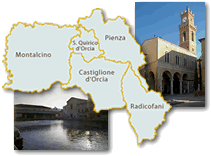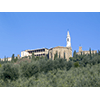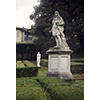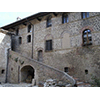Val d'Orcia

Characterised by its low rolling hills, the Val d’Orcia conserves interesting architectural tokens mainly dating to the medieval and Renaissance epochs. The presence of the ancient Via Francigena, which connect Italy to the most important destinations of pilgrimage beyond the Alps, gave rise to several hospitals, like the fortified Grange of Spedaletto, and the development of spa localities like Bagno Vignoni.
Pienza, Boccaccio’s ancient Corsignano, represents one of the best preserved examples of Renaissance town planning. Transformed in the epoch of Pius II according to the canons of the "ideal city", it conserves the rigorous geometrical layout which hinges on the famous trapezoidal square, still surrounded by fifteenth-century buildings.

With its quadrangular plan organised around a porticoed courtyard, Palazzo Piccolomini is one of the monumental buildings that Pius II erected in reorganising his native village Corsignano, which he decided during a visit in 1459. Councillor of Pius II, Leon Battista Alberti suggested the name of Florentine architect Bernardo Rossellino as the designer of the entire complex. The old village was transformed into one of the best-executed "ideal cities" of the 15th century: the new trapezoidal square was grafted onto the pre-existing urban fabric, sited on the hill and based on a longitudinal road network. Around the square stand the cathedral, the bishop’s palace, town hall and the papal palace. The square is characterised by a particular perspective organisation, making it possible to visually dilate space and render the Val d’Orcia immediately perceptible behind the monumental buildings. The metric scale of this urban space is the well next to Palazzo Piccolomini.
The Palazzo is embellished by a small hanging garden, created between 1459 and 1462 by order of the Pope himself, on a project by Rossellino. The garden is enclosed on three sides by high ivy-covered walls, while the fourth has three superimposed rows of arches, which characterise the southern facade of the papal residence. It has a system of drainpipes that prevents rain water from penetrating into the rooms below. The arrangement of space proposes anew the characteristics of Renaissance gardens: the flower-beds with double box hedges draw two perpendicular lanes with a fountain at their point of intersection. An octagonal well in the garden bears the coat of arms of the Piccolomini family. From the loggia, one can admire a spectacular panorama of the Val d’Orcia and Mount Cetona.
(Graziano Magrini)
Leaving Pienza and taking SS146/SP146, after 10 km you come to the centre of San Quirico d’Orcia where you can admire an interesting example of sixteenth-century Italian garden.

The Horti Leonini is a small and very original universe that abounds in literary, artistic and scientific contents, which enclose invisible correlations between microcosm and macrocosm. It was realised by Diomede Leoni, right-hand man of the Medici family, who in 1535 received from Francesco I a piece of land amidst the bastions of San Quirico.
Designed around 1581 by its owner and named after him, the garden is a fascinating example of a classic Italian garden, joined to a wooded area. The particular conformation of the land led Leoni to divide it into two parts. The lower area is rhombus-shaped and contains an Italian garden with a hexagonal shape, conceived as a transfiguration of the circumference. The beds are bordered by a double box hedge and separated by a series of lanes that converge towards the centre where, in 1688, a statue of Grand Duke Cosimo III de’ Medici was placed. The centre lane of the Italian garden leads to a stairway that connects it to the upper area consisting of a wood of centuries-old holm-oaks around a grassy meadow, and traversed by winding paths. The Horti Leonini Garden is embellished by statues with symbolic connotations and inscriptions celebrating Diomede Leoni.
Property of the Commune of San Quirico d’Orcia since 1975, Horti Leonini has been subjected to conservation directed by the Supervisory Service for the Environmental and Architectural Heritage of the Provinces of Siena and Grosseto.
(Graziano Magrini)
Along the road that connects San Quirico to Bagno Vignoni, a little detour on SP53 towards La Foce-Chianciano Terme leads to the Spedaletto Castle, an old grange administered, since the Middle Ages, by the Santa Maria della Scala Hospital of Siena.
A few kilometres away, the baths of Bagno Vignoni are well worth a visit, famous for their curative waters and for having hosted illustrious personages like Lorenzo the Magnificent.

Built in the 12th century by the monk Ugolino da Rocchione, Spedaletto Castle was born to host the pilgrims and wayfarers who travelled the old Via Francigena, one of the most important roads in Europe in the Middle Ages. Like many other fortified structures in the province of Siena, the complex fell under the influence of the Spedale di Santa Maria della Scala as of the 13th century. The original square-plan structure with corner towers and projecting stone corbels, was fortified between the late 15th century and the early 16th century, with the addition of a slight escarpment and embrasures for the use of fire arms.
The splendidly preserved castle today houses an agritourism facility.
(Elena Fani)
Alternatively, continuing southbound for 16 km more on SR2 and SP61, you can wind up your itinerary with a visit to a second spa locality, it too, quite popular since antiquity for the therapeutic properties of its waters.
At Bagno Vignoni, an enchanting village in the Commune of San Quirico d'Orcia, there is a medieval pool of thermal water, around which stood houses, inns, and later the church of San Giovanni Battista. The numerous archaeological findings unearthed here show that the water was already utilised in Roman times. In later ages Bagno Vignoni was visited by famous personages, foremost among them Lorenzo the Magnificent and Enea Silvio Piccolomini (Pope Pius II). The water was analized and described by the naturalist Giorgio Santi, but its usefulness was not limited – as noted by Emanuele Repetti – to its therapeutic effects alone; it served, in fact, to put "in motion 5 or 6 mills built one above another inside the travertine caves."
Today, thanks to rearrangement of the area carried out by the Commune and the ensuing inauguration of the "Park of the Mills", visitors can admire some of the buildings mentioned by Repetti, which remained abandoned up to the middle of the 1950s. The activity of milling was, in fact, along with that of the baths, one of Bagno Vignoni's major resources.
(Graziano Magrini)
****************************
Texts by Elena Fani
English translation by Victor Beard
Last update 11/feb/2008



 = libraries and archives
= libraries and archives  = scientific research centers
= scientific research centers  = memorial places of scientists
= memorial places of scientists = public health places
= public health places = places of science and worship
= places of science and worship = places of technology
= places of technology  = museums and collections
= museums and collections  = villas and gardens of science
= villas and gardens of science


